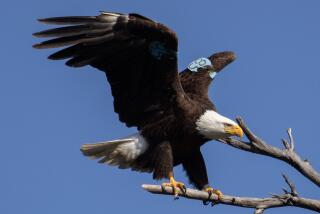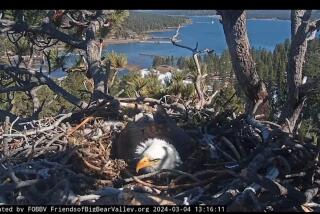A Symbol Soars in the Alaskan Sky : Wildlife: Bald eagles are gathering at the Chilkat Preserve for annual salmon feast. Their numbers are down, but the bird is still thriving.
- Share via
CHILKAT EAGLE PRESERVE, Alaska — It was the largest gathering of bald eagles on Earth. Hundreds upon hundreds of eagles converged at the Chilkat Eagle Preserve in Southeast Alaska as they do every year from mid-October to mid-January.
As many as 1,228 eagles were counted here on one recent day, with 40 perched in a single cottonwood tree. What draws the eagles is a late run of salmon in the 3-mile stretch of the Chilkat River that is warmed by underground springs. All other Alaskan rivers that salmon run are normally frozen this time of year.
For 3 miles along the shallows of the free-flowing river, scores of American bald eagles were ripping away at spawned-out salmon carcasses.
It was a noisy feast.
As fish were devoured by the huge black birds with white heads, white tail feathers, yellow talons and yellow beaks, other bald eagles flew back and forth, a few feet overhead, waiting to land and share the spoils.
But the diners were gluttons, refusing to share their bounty. Between gulps, they glared steely-eyed and shrieked raucously at the hovering birds. The air was alive with sounds of screeching eagles.
When the airborne eagles attempted to displace those eating, shoving matches ensued and the piercing cries of eagles berating one another echoed throughout the snowy wilderness.
“Sometimes their talons lock, but they never seem to inflict serious harm to one another,” observed Alaska State Park Ranger Bill Zack, viewing the incredible scene on the shores of the Chilkat River. “There are no bloody battles. They become a lot less aggressive as their stomachs get full.”
Zack, a tall, husky, black-bearded man, is Alaska’s eagle ranger. He has been the only ranger assigned to the 48,000-acre Chilkat Eagle Preserve since it was set aside by the state seven years ago.
He counts the eagles along the river from time to time. He administers first aid to sick eagles and to eagles that have been shot or have been hit by vehicles on the two-lane Haines Highway next to the Chilkat River.
Though only one eagle has been killed by a car this year, the eagle count is way down. The highest number this winter was 1,228, compared with a 3,700 in 1984.
“The count fluctuates year to year,” Zack said. “There have been years with fewer eagles, but since 1984, their numbers have been fairly consistent, between 3,000 and 3,700.”
Mike Jacobson, wildlife biologist and eagle management specialist for U. S. Fish and Wildlife Service in Juneau, speculates the numbers are down because the run of salmon in the Chilkat River was lighter than usual this year and the weather in Southeast Alaska was warmer than usual, providing the eagles with plenty of food elsewhere.
“We do not believe the (Exxon Valdez) oil spill is a factor, because these eagles nest in nearby Southeast Alaska, in the Yukon, British Columbia and Washington and fly here from the east and south, not from the north, where the spill occurred,” Jacobson said.
There is some concern about foreign fishing fleets intercepting salmon off Alaskan shores and depleting numbers of fish returning to spawn, but the experts haven’t yet determined whether the extensive offshore fishing has anything to do with the lighter-than-usual run of salmon on the Chilkat River.
The count may be down, but the casual observer would never know it. The snowy cottonwood trees along the Chilkat are peppered with the black and white birds.
“We keep the turnouts (on the highway) free of snow so people can park their cars to view the eagles,” said Pete Lapham of the Alaska Department of Highways. “As it is, people get so excited when they spot the first eagles, they slam on their brakes, stop their cars in the middle of the road, run out and start shooting pictures.”
Every year, there are fender benders and accidents along Haines Highway in the area where the birds are feeding.
Photographers come here from all over the United States and from many parts of the world to photograph the great congregation of bald eagles. A dozen photographers from Spain were here recently.
“This is my sixth year,” said Frank Oberle of St. Louis. “To me, this is the ninth wonder of the world.”
Manabut Tozuka, a Tokyo noodle maker, said he saved up for three years to fly to Alaska just to photograph the eagles at Chilkat Eagle Preserve.
“Seeing these wonderful birds all over the trees, feeding on salmon up and down the river is the most exciting adventure of my life,” Tozuka said. “I’m going to start saving as soon as I get home for my next trip here.”
Located 120 miles north of Juneau, Alaska’s capital, the tiny town of Haines calls itself the American Bald Eagle Capital of the World. Townspeople raised $108,000 through donations and by holding pancake breakfasts, fairs and flea markets to build the American Bald Eagle Foundation Research Center, which is affiliated with the University of Alaska’s Southeast Campus at Juneau.
Alaska has an estimated 30,000 to 40,000 eagles, three-fourths of America’s bald eagle population.
Three eagle experts from U. S. Fish and Wildlife, Sid Morgan, Jim King and the late Fred Robards, all of Juneau, are credited with doing more to protect and ensure the preservation of Alaska’s bald eagles than anyone else. As a result of their work, Alaskan eagles have never been on the endangered species list as they were in the Lower 48.
Beginning in 1960, the three men made surveys by air, by boat and on foot throughout Southeast Alaska, recording the giant eagle nests in treetops. The nests are used year after year, with the earliest dating to 1907.
Then they tagged eagle nest trees with yellow fiberglass markers that read: “Bald eagle nest tree. This nest is protected by the Bald Eagle Act. Destruction of eagles or their nests is prohibited by federal law.”
Logging is prohibited in a 330-foot buffer zone around each eagle nest tree in Alaska.
“If timber companies had harvested the nest trees, it could have wiped out much of Alaska’s bald eagle population,” said Morgan, who recalled that bounties were paid for killing the birds in Alaska from 1917 to 1952.
Anybody caught shooting a bald eagle today is subject to a fine of up to $10,000 and two years’ imprisonment.
So now the trees, the sky and the shallows of the Chilkat River are alive with America’s national symbol.
More to Read
Sign up for Essential California
The most important California stories and recommendations in your inbox every morning.
You may occasionally receive promotional content from the Los Angeles Times.










